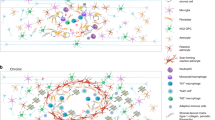Summary
Left dorsal cordotomy at the 11th thoracic vertebra was performed in mature female rats. Local exposures of 1,000 R of 280 kvp x rays were made within 10 min, 12, 24 36 or 48 hrs after injury. Tritiated thymidine (1 μCi/g body wt.) was injected i. v. 1 hr before death and necropsy examination 5, 18 or 30 days after surgery. Hematoxylin-stained sagittal sections (5 μ) of the spinal cord were prepared for radioautographic examination. The parameters of magnitude and duration of changes in cell numbers and numbers of cells incorporating tritiated thymidine were determined for scar parenchymal cells (neuroglia and fibroblasts), macrophage, endothelia and mitotic cells.
Irradiation modified the cellular composition of the developing scar tissue. These changes were due to a delay of proliferation in scar parenchymal and endothelial cell populations. A concomitant suppression of the number of cells incorporating tritiated thymidine occurred in 5-day old irradiated lesions. The magnitude and duration of these delays varied with the cell type and the time of irradiation after injury.
These changes indicate that scar parenchymal and endothelial cells proliferatein situ from progenitor cell populations that were in the lesions at the time of irradiation.
Macrophage cell numbers and numbers of these cells incorporating tritiated thymidine were not decreased after irradiation. It is, therefore, probable that the majority of the macrophage cells did not originate from a local progenitor cell population.
Zusammenfassung
Bei erwachsenen weiblichen Ratten wurde eine linksseitige dorsale Chordotomie in Höhe des 11. BWK durchgeführt. Lokale Röntgenbestrahlung mit einer Dosis von 1000 r bei 280 KVP binnen 10 min wurde 12, 24, 36 und 48 Std nach dem Trauma durchgeführt.3H-markiertes Thymidin (1 μCi/kg) wurde 1 Std vor der Tötung i.v. appliziet. Die autoptische Untersuchung erfolgte 5, 18 und 30 Tage nach dem Eingriff. Mit Hämatoxylin gefärbte Sagittalschnitte (5 μ Dicke) des Rückenmarks wurden autoradiographisch untersucht. Die Parameter der Größe und Dauer der Veränderungen der Zellzahl sowie dez Zahl der3H-Thymidin-markierten Zellen wurden für die Narbenparenchymzellen (Neuroglia und Fibroblasten), Makrophagen, Endothelzellen und Mitosen in der Narbe bestimmt.
Die Bestrahlung veränderte die Zellzusammensetzung in dem sich entwickelnden Narbengewebe infolge verzögerter Proliferation der Parenchym- und Endothelzellen. In 5 Tage alten bestrahlten Läsionen erfolgte eine gleichzeitige Verminderung der3H-Thymidin inkorporierenden Zellen. Die Stärke und Dauer dieser Verzögerung schwankte je nach Zelltyp und Bestrahlungszeit nach dem Trauma.
Die Befunde sprechen dafür, daß Narbenparenchyn- und Endothelzellen bei der Narbenbildung in situ aus ortsständigen Zellpopulationen gebildet werden, die bereits zum Zeitpunkt der Bestrahlung in der Läsion vorliegen.
Die Zahl der Makrophagen sowie der3H-Thymidin-inkorporierenden Zellen war nach der Bestrahlung nicht vermindert. Es ist daher wahrscheinlich, daß die Mehrzahl der Makrophagen nicht aus ortsständigen Zellvorläufern entsteht.
Similar content being viewed by others
References
Altman, J.: Autoradiographic study of degenerative and regenerative proliferation of neuroglia cells with tritiated thymidine. Exp. Neurol.5, 302–318 (1962).
Cammermeyer, J.: Reappraisal of the perivascular distribution of oligodendrocytes. Amer. J. Anat.106, 197–293 (1960)
Clemente, C. D.: Regeneration in the vertebrate central nervous system. In:Pfeifer, C., C. Sytheis, andJ. R. Sytheis (ed.): International Review of Neurobiology, pp. 258–293 New York: Academic Press 1964
Fowler, J. F.: Radiation biology as applied to radiotherapy, pp. 303–364. In:Elbert, M., andA. Howard (eds.) Current Topics in Radiation Research, Vol. 2, pp. 303–364. Amsterdam: North Holland Publishing Co. 1966.
Glucksmann, A.: Cell turnover in the dermis. In:Montagna, W., andR. E. Billingham (eds.): Advances in biology of skin, Vol. V. Wound healing, pp. 74–94. New York: The MacMillan Co. 1964.
Grillo, H. C.: Origin of fibroblasts in wound healing: An autoradiographic study of inhibition of cellular proliferation by local x-irradiation. Ann. Surg.157, 453–467 (1963).
Huntington, H. W., andR. D. Terry: The origin of the reactive cells in cerebral stab wounds. J. Neuropath. exp. Neurol.25, 646–653 (1966).
Kodak materials for nuclear physics and autoradiograph. Pamphlet No. P-64: Rochester, N. Y., Eastman Kodak Co. (1963).
Konigsmark, B. W., andR. L. A. Sidman: Origin of brain macrophages in the mouse. J. Neuropath. exp. Neurol.22, 643–676 (1962).
Patt, H. M., andH. Quastler: Radiation effects on cell renewal and related systems. Physiol. Rev.43, 357–396 (1963).
Puck, T. T., andP. I. Marcus: Action of x-rays on single mammalian cells. J. exp. Med.103, 653–666 (1956).
Ramon y Cajal, S.: Degeneration and Regeneration of the Nervous System, Vol. I and II, 1928. Translated and edited byMay, R. M. New York: Hafner Publishing Co. 1959.
Russel, G. V.: The compound granular corpuscle or gitter cell: A review, together with notes on the origin of this phagocyte. Tex. Rep. Biol. Med.20, 338–351 (1962).
Spector, W. G., M. N.-I. Walters andD. A. Willoughby: The origin of the mononuclear cells in inflammatory exudates induced by fibrinogen. J. Path. Bact.90, 181–192 (1965).
Tietz, W. J.: The effects of parenteral trypsin therapy for spinal cord hemisection in sheep. Ph. D. Thesis, Purdue University 1961.
Turbes, C. C., L. W. Freeman, andD. C. Gastineau: X-ray radiation of experimental lesions of the spinal cord. Neurology (Minneap.)10, 84–89 (1960).
Wolkman, A., andJ. L. Gowans: The production of macrophages in the rat Brit. J. exp. Path.46, 50–61 (1965).
——: The origin of macrophages from bone marrow in the rat. Brit. J. exp. Path.46, 62–70 (1965).
Von Borstel, R. W.: Effects of radiation on cells. In:Schwartz, E. E. (ed.): The Biological Basis of Radiation Therapy, pp. 60–125. Philadelphia: J. B. Lippincott Co. 1966.
Whitmore, G. F., andJ. E. Till: Quantitation of cellular radiobiological responses. Ann. Rev. nuclear Sci.14, 347–374 (1964).
—,S. Gulyas, andJ. Boland: Radiation sensitivity throughout the cell cycle and its relationship to recovery. In: Cellular Radiation Biology, pp. 423–440. Baltimore: The Williams Wilkins Co. 1965.
Author information
Authors and Affiliations
Rights and permissions
About this article
Cite this article
Ticer, J.W., Tietz, W.J. Radiation-induced cellular changes in traumatic spinal cord injury. Acta Neuropathol 13, 122–130 (1969). https://doi.org/10.1007/BF00687024
Received:
Issue Date:
DOI: https://doi.org/10.1007/BF00687024




